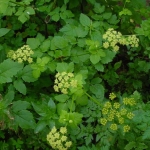| Common Name: |
Lavose |
| Other Names: |
Bladder Seed, Lovage, Love Parsley, Sea Parsley, Smallage, Smellage |
| Botanical Name: |
Levisticum officinale Syn. Ligusticum levisticum |
| Genus: |
Levisticum |
| Family: |
Apiaceae |
| Native Location: |
E Mediterranean |
| Cultivation: |
Deep, rich, moist soil in sun or partial shade. Leaves may be damaged by leaf miners. |
| Propagation: |
By seed sown in autumn; by division in spring. |
| Harvest: |
Leaves are picked before flowering and distilled for oil or dried for use in infusions. Stems are cut in spring, when tender and succulent. Roots are lifted in the third year, and used fresh, or dried for decoctions, liquid extracts, tinctures, and oil distillation. Seeds are collected when ripe and dried for use in decoctions. |
| Height: |
2m (6ft) |
| Width: |
1m (3ft) |
| Hardiness: |
Z5-8 |
| Parts Used: |
Leaves, stems, roots, seeds, oil, Rhizones, Fruit |
| Properties: |
A bitter-sweet, sedative herb, pungently aromatic, that benefits the digestion, relaxes spasms, increases perspiration, and acts as a diuretic and expectorant. It is effective against many disease-causing organisms. |
| Medicinal Uses: |
Internally for indigestion, colic, gas, poor appetite, kidney stones, cystitis, painful menstruation and slow labor. Externally for sore throat and aphrhous ulcers.
To treat indigestion, flatulence, menstrual problems, gastric conditions; to prevent kidney gravel. |
| Typical Dose: |
A typical dose of lovage may range from 1.5 to 3.0 gm of finely chopped root mixed with 150 ml boiling water, steeped for ten to fifteen minutes, strained, and taken as a tea, two to three times a day. |
| Possible Side Effects: |
Lovage's side effects include allergic reactions and skin sensitivity to sun. |
| Drug Interactions: |
| Taking lovage with these drugs may increase skin sensitivity to sunlight |
| Bumetanide, (Bumex, Burinex) |
Celecoxib, (Celebrex) |
Ciprofloxacin, (Ciloxan, Cipro) |
Doxycycline, (Apo-Doxy, Vibramycin) |
| Enalapril, (Vasotec) |
Etodolac, (Lodine, Utradol) |
Fluphenazine, (Modecate, Prolixin) |
Fosinopril, (Monopril) |
| Furosemide, (Apo-Furosemide, Lasix) |
Gatifloxacin, (Tequin, Zymar) |
Hydrochlorothiazide, (Apo-Hydro, Microzide) |
Ibuprofen, (Advil, Motrin) |
| Indomethacin, (Indocin, Novo-Methacin) |
Ketoprofen, (Orudis, Rhodis) |
Ketorolac, (Acular, Toradol) |
Lansoprazole, (Prevacid) |
| Levofloxacin, (Levaquin, Quixin) |
Lisinopril, (Prinivil, Zestril) |
Loratadine, (Alavert, Claritin) |
Methotrexate, (Rheumatrex, Trexall) |
| Naproxen, (Aleve, Naprosyn) |
Nortriptyline, (Aventyl HCl, Pamelor) |
Ofloxacin, (Floxin, Ocuflox) |
Omeprazole, (Losec, Prilosec) |
| Phenytoin, (Dilantin, Phenytek) |
Piroxicam, (Feldene, Nu-Pirox) |
Prochlorperazine, (Compazine, Compro) |
Quinapril, (Accupril) |
| Risperidone, (Risperdal) |
Rofecoxib, (Vioxx) |
Tetracycline, (Novo-Tetra, Sumycin) |
| Taking lovage with these drugs may increase the risk of bleeding or bruising: |
| Abciximab, (ReoPro) |
Aminosalicylic Acid, (Nemason Sodium, Paser) |
Antithrombin III, (Thrombate III) |
Argatroban, (Argatroban) |
| Aspirin, (Bufferin, Ecotrin) |
Aspirin and Dipyridamole, (Aggrenox) |
Bivalirudin, (Angiomax) |
Choline Magnesium Trisalicylate, (Trilisate) |
| Choline Salicylate, (Teejel) |
Clopidogrel, (Plavix) |
Dalteparin, (Fragmin) |
Danaparoid, (Orgaran) |
| Dipyridamole, (Novo-Dipiradol, Persantine) |
Enoxaparin, (Lovenox) |
Eptifibatide, (Integrillin) |
Fondaparinux, (Arixtra) |
| Heparin, (Hepalean, Hep-Lock) |
Indobufen, (Ibustrin) |
Lepirudin, (Refludan) |
Salsalate, (Amgesic, Salflex) |
| Ticlopidine, (Alti-Ticlopidine, Ticlid) |
Tinzaparin, (Innohep) |
Tirofiban, (Aggrastat) |
Warfarin, (Coumadin, Jantoven) |
|
| Disease Effects: |
- May worsen hypertension by increasing sodium retention.
- May worsen kidney inflammation or impaired kidney function.
|
| Culinary Uses: |
Young shoots and leaf stalks are blanched and eaten as a vegetable, stalks are also candied like angelica. Seeds are added to soups, bread, and biscuits. Leaves are added to soups, stews, salads, and savory dishes. Dried leaves are made into tea. |
| Economic Uses: |
Oil is used in commercial food flavoring, alcoholic drinks, and in perfumery. |
| Bibliography: |
The Encylopedia of Herbs by Deni Bown Copyright © 1995, 2001 Dorling Kindersley Limited pp 259-260
The Essential Herb-Drug-Vitamin Interaction Guide by Geo. T. Grossberg,MD and Barry Fox,PhD Copyright©2007 Barry Fox,PhD. Pp315-316 |

